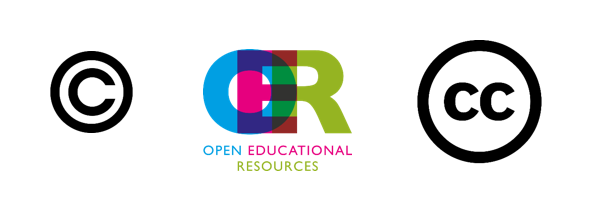Generale
FAQ auf Deutsch ansehen.

OER are open educational resources that are deliberately made open by the author and furnished with certain rights of use (so-called licences) in order to allow for the simple use, further processing and publication of educational materials. Open educational resources include, for example, all types of course materials, texts, images, audio content, videos, educational software and complete course units.
See also the UNESCO definition.
OER are seen as having great potential in the area of university teaching, for example in supporting methodological-didactic approaches as well as in updating and further developing standardised and rapidly changing educational content and even in supporting individual teaching-learning processes.
What are OERs?
By loading the video, you accept YouTube's privacy policy.
OER are
educational resources that can be openly used, adapted and republished – for
any purpose. Creative Commons licences, especially CC0, CC-BY and CC-BY-SA licences, allow
this type of subsequent use.
The CC licence represents permission for the free use of copyright protected
works under the conditions of the respective licence. It is not required to
obtain separate permission from the authors or to conclude an individual
agreement.
You can also find answers to many of the questions you have about OER in the
“Creative Commons licences” section of this FAQ list.
In the ZHAW Open Educational Resources (OER) Policy, ZHAW staff and students are expressly called on to publish their materials as OERs under a CC-BY or CC-BY-SA licence.
The e-learning strategies of individual Schools also support the publication of OERs, for example the
However, please note that under the FaHG law governing the Zurich universities of applied sciences and arts (§16 a. (1)) you require the approval of your line managers, as the usage rights for works that you create in performing your official duties lie with the ZHAW.
At the ZHAW, there is an OER community with a TEAMS channel for self-registration. Members share their OER, their experience with OER projects, and questions as well as news related to OER. Furthermore, there are networking events with presentations, discussions, and good practices.
All of ZHAW staff is welcome to join the OER community.
Switch OER, the portal for OER from Swiss higher education institutions, includes open educational materials from all subject areas, languages and media types. The aim is to create a central collection of OER from ZHAW and other participating institutions.
Log in to Switch OER with your Switch edu-ID and upload your material. You can also link to OER that you published on other platforms.
If you have any questions about Switch OER, please contact us at oer.hsb@zhaw.ch.
Switch OER is the portal for OER from Swiss higher education institutions. It was launched in 2024 by the ZHAW together with Switch and other Swiss universities.
The aim of Switch OER is to create a central collection of OER from the Swiss higher education landscape. It covers open educational materials from all subject areas, languages, and media types.
Log in to Switch OER with your Switch edu-ID and upload your material.
You can also link to OER that you published on other platforms.
If you have any questions about Switch OER, please contact us at oer.hsb@zhaw.ch.
Copyright is divided into moral rights and rights of use.
Under the FaHG law governing the Zurich universities of applied sciences and arts (§16 a. (1)), the rights of use for copyright protected works that have been created by university staff in performing their official duties lie with the university.
Upon publishing such a work under a CC licence, the rights of use remain with the ZHAW, although not exclusively. A corresponding order or consent from your line manager is thus required. For reasons of proof, you should give preference to the provision of written confirmation of consent (e.g. e-mail).
Be sure to
always obtain the consent of each person whose face or voice you would like to
publish in images, videos or audio recordings under a CC licence. Here you can find a form for requesting consent. Keep the
consent for reasons of proof.
In CC-licensed material for third parties wishing to subsequently use the
material, indicate that consent has been provided. You can find a disclaimer in the Information sheet on CC licences and publishing open educationalresources (OER) at the ZHAW.
The use of the ZHAW logo in materials under CC licence is permitted. Wherever possible, include a disclaimer, for example:
When using intros / outros or other media elements of the Schools, make sure that it is allowed to publish these under a CC licence.
See more in the Information sheet on CC licences and publishing open educationalresources (OER) at the ZHAW.
The University Library’s OER team will advise you on any questions you may have about Creative Commons licences, copyright, and open educational resources (OER). We are looking forward to receiving your e-mail at: oer.hsb@zhaw.ch.
OER Logo Open Educational Resources.png von Markus Büsges (leomaria design) für Wikimedia Deutschland e. V., steht unter CC BY-SA 4.0